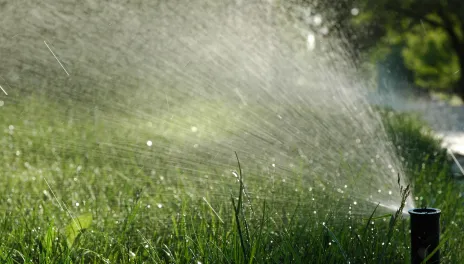Fall Weed Control in the Lawn
Hello! I hope you’re having a great day.
We received rain again in the past week! We received between 0.88 to 2.07 inches of rain. Temperatures were near normal in the past week.
The crops are progressing nicely. Dry bean harvest has begun.
The fall is an excellent time of the year to control perennial and biennial weeds in your lawn. Some of these perennial species include white clover, dandelion, ground ivy and plantain species. Perennial and biennial weeds are starting to prepare themselves for winter so they can grow again next year. They are sending nutrients down to the roots and crowns that allow them to survive the winter. When translocating herbicides are applied in the fall the herbicide travels with the nutrients to the roots and crowns and kills the plant more effectively than a spring application.
Wait to apply the herbicides until after a frost and then wait for a few warm (greater than 60 degrees Fahrenheit) days to spray. It is always best to have warm days before, during, and after the application. However, it is better to apply the herbicides during cool weather than to wait to spray until the spring. When spraying in cool weather make sure the night time temperatures are as much above freezing as possible. Spraying under less than ideal conditions should not negatively impact weed control, but it will certainly take longer to kill the plants.
When spraying the herbicides to the weeds always allow at least a six-hour rainfree period after the application. If using a dry weed and feed product you should apply that when there is a dew or slightly water after application. Dry weed and feed products do not control weeds as effectively as a spray.
We have had enough rain now that the weeds should no longer be under water stress allowing the herbicides to effectively control the weeds.
It is best to not mow at least three days before and after the herbicide application to allow for maximum uptake of the herbicides. Allow the grass to be over three inches tall to allow for more leaf surface for the herbicide to get into the weed.
The most common and effective herbicides to control most lawn weeds would be products such as Trimec and Triplet and other products that contain 2,4-D, MCPP, and dicamba. Read the label of these products to know how much to apply. For example, the rate of Triplet is 3 to 4 pints per acre or 1.1 to 1.5 fluid ounces per 1000 square feet when applying to ryegrass, bluegrass, and fescue. If you know what a 20 gallon per acre spray volume looks like on the leaf surface then at the 4 pints per acre rate you would need to add 3.2 fluid ounces of Triplet to 124.8 fluid ounces of water.
To go after ground ivy, oxalis and clover you need to use the active ingredient triclopyr. This can be purchased in a four-way mixture of triclopyr, sulfentrazone, 2,4-D, and dicamba which is called T Zone SE. The rate of T Zone is 3.25 to 4 pints per acre for applying to ryegrass, bluegrass, and fescue. The other option is to add Turflon Ester (triclopyr) at 0.5 to 1 pt/A to a product like Triplet (2,4-D, MCPP, plus dicamba). At the 1 pt/A rate you would need to add 0.8 fluid ounces to 127.2 fluid ounces of water.
Dicamba and triclopyr can be hard on trees, so do not spray trees or get the spray on any exposed roots. There may still be some risk to trees where the roots are shallow, but covered with soil.
When using herbicides please read and follow the label as it is the law.
If you do not like weeds in your lawn, then we are approaching the best time of year to control them. Happy weed killing.
